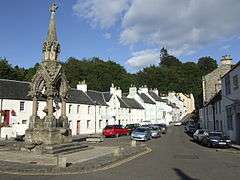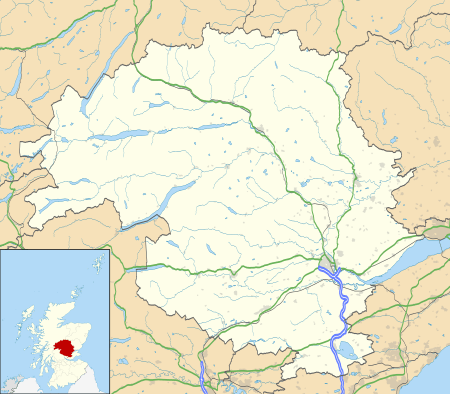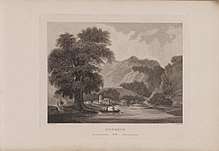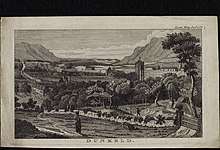Dunkeld and Birnam
Dunkeld and Birnam is a community council area and UK Census locality in Perth and Kinross, Scotland, consisting of two villages on opposite banks of the River Tay: the historic cathedral "city" of Dunkeld on the north bank, and Birnam on the south bank. The two were first linked by a bridge built in 1809 by Thomas Telford.[2] The two places lie close to the Highland Boundary Fault, which marks the geological boundary between the Highlands and the Lowlands, and are frequently described as the "Gateway to the Highlands" due to their position on the main road and rail lines north.[3] Dunkeld and Birnam share a railway station, Dunkeld & Birnam, on the Highland Main Line, and are about 24 kilometres (15 mi) north of Perth on what is now the A9 road.[4]
Dunkeld and Birnam
| |
|---|---|
 Dunkeld Market Place and fountain | |
 Dunkeld and Birnam Location within Perth and Kinross | |
| Population | 1,287 [1] |
| OS grid reference | NO027425 |
| • Edinburgh | 45 mi (72 km) |
| • London | 376 mi (605 km) |
| Community council |
|
| Council area | |
| Lieutenancy area | |
| Country | Scotland |
| Sovereign state | United Kingdom |
| Post town | DUNKELD |
| Postcode district | PH8 |
| Dialling code | 01350 |
| Police | Scotland |
| Fire | Scottish |
| Ambulance | Scottish |
| UK Parliament | |
| Scottish Parliament | |
Dunkeld (/dʌŋˈkɛl/, Scots: Dunkell,[5] from Scottish Gaelic: Dùn Chailleann, "fort of the Caledonians"[6]) lies on the eastern side of the A9 on the north bank of the River Tay.[4] The town is the location of Dunkeld Cathedral. Around 20 of the houses within Dunkeld have been restored by the National Trust for Scotland, who run a shop within the town.[7] The Hermitage, on the western side of the A9, is a countryside property that is also a National Trust for Scotland site.[4][8]
Birnam lies opposite Dunkeld, on the south bank of the Tay, to which it is linked by the Telford bridge.[9] It is the location of the Birnam Oak, believed to be the only remaining tree from the Birnam Wood named in Shakespeare's Macbeth.[3] The Highland games held at Birnam are the location of the World Haggis Eating Championships.[10]
History
Early history
The name Dùn Chailleann means Fort of the Caledonii or of the Caledonians. The 'fort' is presumably the hill fort on King's Seat, slightly north of the town (NO 009 430).[11] Both these place-names imply an early importance for the area of the later town and bishop's seat, stretching back into the Iron Age.
Dunkeld (Duncalden and variants in early documents) is said to have been 'founded' or 'built' by Caustantín son of Fergus, king of the Picts (d. 820). This founding likely referred to one of an ecclesiastical nature on a site already of secular importance, and a Pictish monastery is known to have existed on the site.[12] Kenneth I of Scotland (Cináed mac Ailpín) (843–58) is reputed to have brought relics of St Columba from Iona in 849, in order to preserve them from Viking raids, building a new church to replace the existing structures,[13] which may been constructed as a simple group of wattle huts. The relics were divided in Kenneth's time between Dunkeld and the Columban monastery at Kells, Co. Meath, Ireland, to preserve them from Viking raids. The 'Apostles' Stone', an elaborate but badly worn cross-slab preserved in the cathedral museum, may date to this time.[12] A well-preserved bronze 'Celtic' hand bell, formerly kept in the church of the parish of Little Dunkeld on the south bank of the River Tay opposite Dunkeld, may also survive from the early monastery: a replica is kept in the cathedral museum.
The dedication of the later medieval cathedral was to St Columba. This early church was for a time the chief ecclesiastical site of eastern Scotland (a status yielded in the 10th century to St Andrews). An entry in the Annals of Ulster for 865 refers to the death of Tuathal, son of Artgus, primepscop (Old Irish 'chief bishop') of Fortriu and Abbot of Dunkeld. The monastery was raided in 903 by Danish Vikings sailing up the River Tay, but continued to flourish into the 11th century. At that time, its abbot, Crínán of Dunkeld (d. 1045), married one of the daughters of Máel Coluim mac Cináeda (1005–34) and became the ancestor of later Kings of Scots through their son Donnchad (Duncan I) (1034–40).[14]
Middle Ages

The see of Dunkeld was revived by Alexander I (1107–24). Between 1183 and 1189 the newly formed diocese of Argyll was separated from that of Dunkeld, which originally extended to the west coast of Scotland.[15] By 1300 the Bishops of Dunkeld administered a diocese comprising sixty parish churches, a number of them oddly scattered within the sees of St Andrews and Dunblane.[16]
The much-restored cathedral choir, still in use as the parish church, is unaisled and dates to the 13th and 14th centuries.[12] The aisled nave was erected from the early 15th century. The western tower, south porch and chapter house (which houses the cathedral museum) were added between 1450 and 1475.[17] The cathedral was stripped of its rich furnishings after the mid-16th century Reformation and its iconoclasm. The nave and porch have been roofless since the early 17th century. They and the tower in the 21st century are in the care of Historic Environment Scotland.[13]
Below the ceiling vault of the tower ground floor are remnants of pre-Reformation murals showing biblical scenes (c. 1490), one of very few such survivals in Scotland. The clearest to survive is a representation of the Judgement of Solomon.[18] This reflects the medieval use of this space as the Bishop's Court. Within the tower are preserved fragments of stonework associated with the cathedral and the surrounding area, including a Pictish carving of a horseman with a spear and drinking-horn, and a number of medieval grave-monuments.[18]
The cathedral museum is housed in the former chapter house and sacristy, on the north side of the choir. After the Reformation this chamber was used as a burial aisle by the Earls, Marquises and Dukes of Atholl, and contains a number of elaborate monuments of the 17th-early 19th centuries.[18] Also preserved within the museum are two early Christian cross-slabs, a number of communion and other items, and a display on the history of Dunkeld and the cathedral. In June 2005, there was a major theft from the cathedral museum. Items stolen included a quaich, communion cups, and 'a cast-bronze beadle’s bell with a wooden handle, that was used in the cathedral from the 17th century.'
Battle of Dunkeld (1689)
Most of the original town was destroyed during the Battle of Dunkeld when, in August 1689, the 26th Foot (Cameronian Regiment) successfully fought the Jacobites shortly after the latter's victory at the Battle of Killiecrankie. Holes made by musket-ball strikes during the battle can still be seen in the east gable of the cathedral.[19]
Townscape

The rebuilt town of Dunkeld is one of the most complete 18th-century country towns in Scotland. Many of the harled (rough-cast) vernacular buildings have been restored by the National Trust for Scotland (NTS).[7] The present street layout of the older part of town consists of a 'Y-shaped' arrangement, parallel with the River Tay, comprising a single street (Brae Street/High Street) sloping down from the east into the long 'V' of the market place, known as The Cross. Closes (lanes) leading off this main street give access to the backlands of the houses (a traditional arrangement in Scottish towns). On the site of the traditional market cross, the fanciful neo-Gothic Atholl Memorial Fountain (NTS) was built in 1866, as a monument to George Murray, 6th Duke of Atholl (1814–64). The Fountain is notable for its heraldry and Masonic symbolism, the 6th Duke having been Grand Master of the Grand Lodge of Scotland, 1843–64.
At the west end of The Cross is the Ell Shop (NTS), built 1757, which takes its name from the iron ell (weaver's measure) fixed against one corner. This building is said to have been built on the site of the town's medieval hospital, dedicated to St George. At the north-west corner of the same row is the Duchess of Atholl Girls' School, erected 1853 in neo-Gothic style, designed by R & R Dickson.[20] It is generally known as the Duchess Anne after its founder Anne Home-Drummond (1814–97), spouse of the 6th Duke of Atholl and Mistress of the Robes to Queen Victoria. The building is used for exhibition and other purposes, notably the popular annual Dunkeld Art Exhibition in summer.

The left arm of the 'Y' leads along Cathedral Street to the medieval cathedral, and the right arm (now largely blocked off) originally led to Dunkeld House, built by Sir William Bruce in 1676-84 for the 1st Marquis of Atholl. Demolished in 1827, this was one of Scotland's major 17th-century mansions. A neo-Gothic replacement was begun on the same site but never completed (no visible remains). The area around the Cathedral was the original focus of settlement in Dunkeld in medieval (and doubtless earlier) times. Here stood the manses of the Cathedral clergy, with the Bishop's Palace to the west of the church. This was also the position of the medieval bridge over the River Tay.
The alignment of the town was radically altered in 1809 by the building of a new stone bridge over the River Tay by Thomas Telford at the east end of the town, and the laying out of a new street (Bridge Street–Atholl Street) at right angles to the old alignment. This street, which retains much of its Georgian appearance, was part of the main route north to Inverness until Dunkeld was bypassed in 1977, along with Birnam, by the A9.
Both Birnam and Dunkeld have drill halls: The Perth Road drill hall in Birnam was completed in 1894,[21] whilst the High Street drill hall in Dunkeld was completed in 1900.[22] Birnam also has a community-run arts and performance centre and library, Birnam Arts and Conference Centre.[23]
Surrounding countryside
Dunkeld is situated in an area of Scotland marketed as Big Tree Country.[24] The area is heavily wooded, and has some notable trees, including the Birnam Oak, believed to be the only remaining tree from the Birnam Wood named by Shakespeare in his play Macbeth:[3]
MACBETH: I will not be afraid of death and bane, till Birnam forest come to Dunsinane.
— Shakespeare, Macbeth, Act 5, scene 3.[25]
The Birnam Oak stands a few hundred metres from the centre of Birnam on the Murthly Estate. Traditionally, it was known as "The Hangman's Tree".[26] Other significant trees in the area include Niel Gow's Oak, the tree under which Niel Gow, a fiddler under contract to three of the Dukes of Atholl,[27] composed many of Scotland's famous strathspeys and reels. It stands near Gow's home at Inver. The Parent Larch near Dunkeld cathedral is the sole survivor from a group of larches collected from the mountains of the Tyrol mountains in 1738, and which were the seed source for large-scale larch plantings in the local area.[3]
Much of the countryside surrounding the town is designated as a national scenic area (NSA),[28] one of 40 such areas in Scotland, which are defined so as to identify areas of exceptional scenery and to ensure its protection by restricting certain forms of development.[29] The River Tay (Dunkeld) NSA covers 5,708 ha (14,100 acres).[30] Parts of the area also form part of the Tay Forest Park, a network of forests managed by Forestry and Land Scotland that are spread across the Highland parts of Perthshire.[24] About 2 miles (3 km) to the northeast of the town is the Loch of the Lowes nature reserve, managed by the Scottish Wildlife Trust.[31]
There are many walks in the area.[32] The 404-metre (1,325 ft) summit of Birnam Hill (on Murthly Estate) lies 1.5 km (0.93 mi) south of the railway station and is easily ascended from there, or from a car park to the east.[33]
Ossian's Hall of Mirrors is a folly located in the pleasure grounds known as The Hermitage, located close to Dunkeld and Birnam. The site is owned by the National Trust for Scotland, and has walks in the wooded scenery surrounding the River Braan.[8]
Transport
The A9 through Dunkeld and Birnam was bypassed by a new section of road in 1977.[9] The town is now approximately one hour from Glasgow and Edinburgh, and two hours from Inverness, by car. There are regular bus and coach services to Birnam and Dunkeld along the A9, with long distance coaches operated by Scottish Citylink.[34] There is access by rail at Dunkeld & Birnam railway station on the Highland Main Line route between Perth and Inverness. Most services on the route extend to either Edinburgh Waverley or Glasgow Queen Street; on Sundays only a southbound train operated by the East Coast Main Line operator extends to London King's Cross via Edinburgh, although there is no corresponding northbound service from London.[35] A daily (except Saturday) London service is offered by the overnight Caledonian Sleeper trains to and from London Euston.[36]
People
John Everett Millais, who painted many local landscapes, and Beatrix Potter, with her family, often visited Birnam. Potter drafted her first book, The Tale of Peter Rabbit, at Eastwood House whilst writing a story and picture letter to child friend Noel Moore on 4 September 1893.[37][38] There is an exhibition and garden dedicated to Potter and her characters located in Birnam.[39]
Frances Anderson, biological mother of comedian Mark Steel was originally from Dunkeld, and owned the village deli.[40]
Dr George Smyttan FRSE HEIC (1789-1863) was born and raised in Dunkeld and retained links to Birnam all his life.
Gallery
 Birnam Wood in 1800
Birnam Wood in 1800 Birnam, Scotland
Birnam, Scotland The Birnam Hotel
The Birnam Hotel The Birnam Arts and Conference Centre
The Birnam Arts and Conference Centre Dunkeld and Birnam Railway Station
Dunkeld and Birnam Railway Station- The Birnam Oak
 Dunkeld House Hotel
Dunkeld House Hotel
See also
References
- "Scotland's Census 2011. Settlement/Locality: Dunkeld & Birnam (S19000184)". National Records of Scotland. Retrieved 23 May 2018.
- "History of Dunkeld and Birnam". Dunkeld and Birnam Tourist Association. Retrieved 7 September 2016.
- "The special qualities of the National Scenic Areas" (PDF). Scottish Natural Heritage. 2010. pp. 127–135. Retrieved 14 May 2018.
- "Blairgowrie & Forest of Alyth", Ordnance Survey Landranger Map (B2 ed.), 2008, ISBN 0-319-23121-6
- "Scotslanguage.com - Names in Scots - Places in Scotland". www.scotslanguage.com. Retrieved 18 July 2019.
- "Ainmean-Àite na h-Alba (AÀA) – Gaelic Place-names of Scotland". www.ainmean-aite.scot. Retrieved 18 July 2019.
- "Dunkeld". National Trust for Scotland. Retrieved 22 May 2018.
- "The Hermitage". National Trust for Scotland. Retrieved 21 May 2018.
- "Thomas Telford's Bridge". Dunkeld & Birnam Tourism Association. Archived from the original on 23 September 2015. Retrieved 22 May 2018.
- "Scot claims haggis eating crown". BBC. 30 August 2008. Retrieved 22 May 2018.
- Historic Environment Scotland. "King's Seat (27172)". Canmore. Retrieved 22 May 2018.
- "Dunkeld Cathedral - History". Historic Environment Scotland. Retrieved 22 May 2018.
- "Dunkeld Cathedral". Historic Environment Scotland. Retrieved 22 May 2018.
- See Royal Commission on the Ancient and Historical Monuments of Scotland (RCAHMS), South-East Perth, Edinburgh: 1994, 89-90, for a summary of the early history of Dunkeld, and descriptions of the 'Apostles' Stone' and other early sculpture.
- RCAHMS Argyll, Volume 2: Lorn, Edinburgh 1974, 160.
- McNeill, P G B & MacQueen, H L (eds) Atlas of Scottish History to 1707, Edinburgh 1996, 353.
- RCAHMS 1994 (op cit), 124.
- "Dunkeld Cathedral - Statement of Significance". Historic Environment Scotland. 18 March 2018. Retrieved 23 May 2018.
- Inglis, John Alexander. (1911). The Monros of Auchinbowie and Cognate Families. pp. 40 – 44. Edinburgh, Privately printed by T and A Constable. Printers to His Majesty.
- Dictionary of Scottish Architects
- "Birnam, Perth Road, Drill Hall & Armoury House". Canmore. Retrieved 24 June 2017.
- "Dunkeld, High Street, Scottish Horse Museum". Canmore. Retrieved 17 December 2017.
- "About Birnam Arts". Birnam Arts. Retrieved 22 May 2018.
- "Tay Forest Park: Tall Trees & Big Views" (PDF). Forestry Commission Scotland. 2015. Retrieved 3 January 2019.
- "Macbeth, Act 5, scene 3". www.shakespeare-online.com. Retrieved 22 May 2018.
- Smout, T. C., MacDonald, R. and Watson, Fiona (2007) A History of the Native Woodlands of Scotland 1500-1920. Edinburgh University Press. ISBN 978-0-7486-3294-7. p.78.
- "Archived copy" (PDF). Archived from the original (PDF) on 21 July 2011. Retrieved 25 May 2011.CS1 maint: archived copy as title (link)
- "Map: River Tay (Dunkeld) National Scenic Area" (PDF). Scottish Natural Heritage. December 2010. Retrieved 21 May 2018.
- "National Scenic Areas". Scottish Natural Heritage. Retrieved 21 May 2018.
- "National Scenic Areas - Maps". SNH. 20 December 2010. Archived from the original on 12 June 2018. Retrieved 21 May 2018.
- "Loch of the Lowes". Scottish Wildlife Trust. Retrieved 22 May 2018.
- "Dunkeld & Birnam Walking & Cycling". Dunkeld & Birnam Tourism Association. Retrieved 22 May 2018.
- "Birnam Hill, Birnam". Walkhighlands. Retrieved 18 July 2019.
- "Timetable:Edinburgh/Inverness" (PDF). Scottish CityLink Coaches Ltd. Retrieved 22 May 2018.
- "Timetable: Edinburgh & Glasgow - Inverness (20 May 2018 – 8 Dec 2018)" (PDF). ScotRail. Retrieved 21 May 2018.
- "Timetable: London - Inverness (20 May 2018 – 8 Dec 2018)". Caledonian Sleeper. Retrieved 22 May 2018.
- "Beatrix Potter's hidden Scottish link". BBC News. 13 July 2016. Retrieved 21 May 2018.
- "History". Eastwood House. Retrieved 21 May 2018.
- "Beatrix Potter Exhibition and Garden". Dunkeld & Birnam Tourism Association. Retrieved 22 May 2018.
- "BBC Radio 4 - Mark Steel - Who Do I Think I Am?". BBC. Retrieved 18 July 2019.
External links
| Wikivoyage has a travel guide for Dunkeld. |
| Wikivoyage has a travel guide for Birnam. |
- Dunkeld and Birnam Tourist Association
- Dunkeld & Birnam at VisitScotland Perthshire*Engraving of a view of Dunkeld by James Fittler in the digitised copy of Scotia Depicta, or the antiquities, castles, public buildings, noblemen and gentlemen's seats, cities, towns and picturesque scenery of Scotland, 1804 at National Library of Scotland
- Engraving of Dunkeld in 1693 by John Slezer at National Library of Scotland
